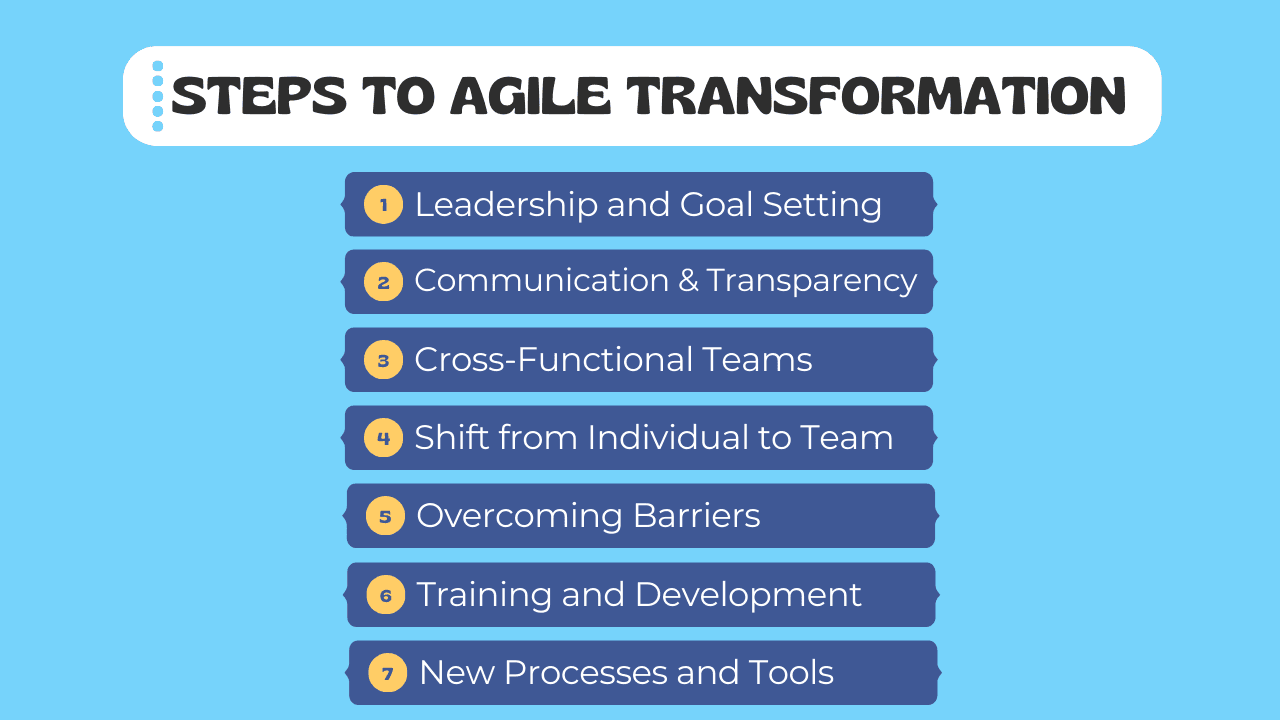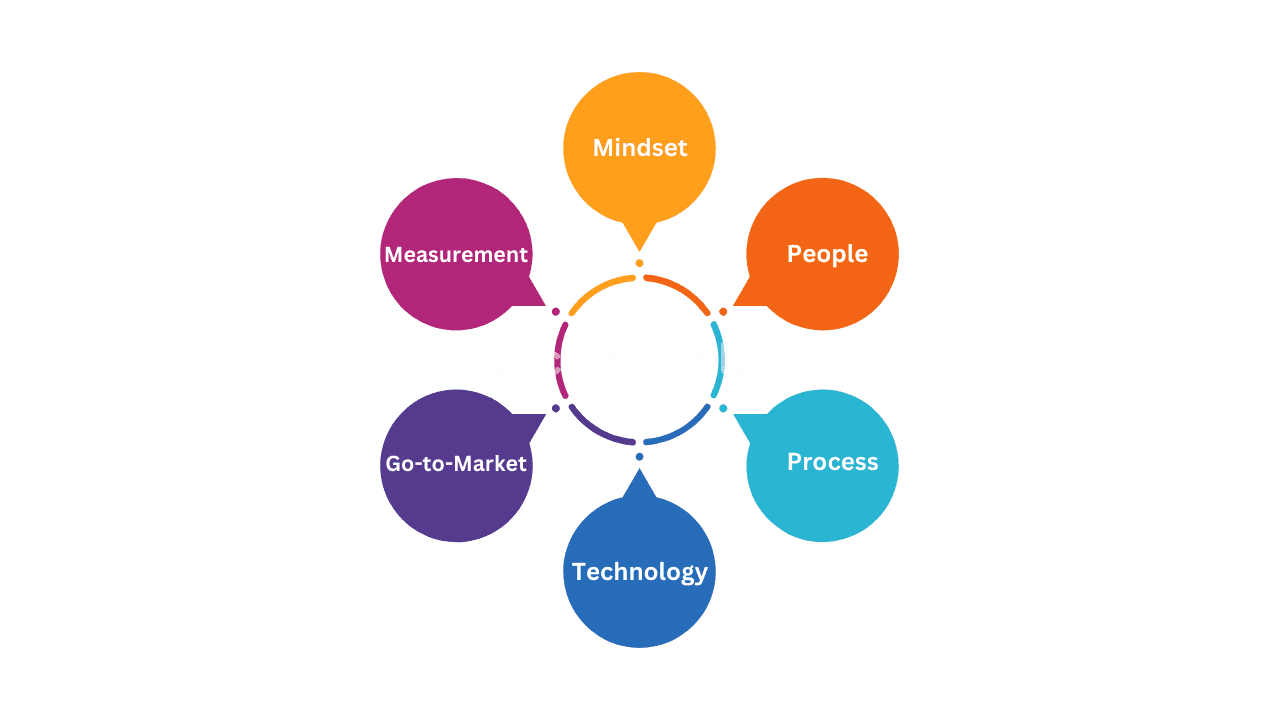
Agile Transformation - Steps, Changes, Benefits, and Challenges
 Agile Transformation - Steps, Changes, Benefits, and Challenges
Agile Transformation - Steps, Changes, Benefits, and Challenges
Agile Transformation represents a paradigm shift in the corporate world, a journey that reshapes an organization's core approach to project management and software development.
Rooted in the principles of the Agile Manifesto, this transformation is more than just adopting new methodologies; it's about embracing a philosophy that values flexibility, collaboration, customer-centricity, and iterative progress.
Agile methodologies like Scrum, Kanban, and Lean are not mere tools but catalysts that drive organizations towards a more dynamic, responsive, and efficient operational model.
💡
This transformation is a comprehensive process, impacting not just workflows and processes but also the very culture and mindset of an organization.
Embarking on an Agile Transformation journey involves a series of strategic shifts and adaptations.
It begins with a cultural metamorphosis, where the values and attitudes of employees evolve to prioritize collaboration, empowerment, and customer value.
This shift is complemented by adopting iterative and incremental delivery models, breaking down work into manageable segments and allowing for continuous feedback and adaptation.
Agile transformation also heralds the formation of cross-functional teams, blending diverse skills and expertise to foster self-organization and direct value delivery.
Table Of Contents-
- What is Agile Transformation?
- Key Components of Agile Transformation
- Why Agile Transformation?
- Steps to Agile Transformation
- Who Drives Agile Transformation?
- Six Areas of Change in Agile Transformations
- Potential Benefits of Agile Transformation
- Challenges in Agile Transformations
- Why Agile Transformation Projects Fail?
- Conclusion
- Frequently asked questions
What is Agile Transformation?
 What is Agile Transformation?
What is Agile Transformation?
Agile transformation is the process of shifting an organization to agile ways of working. Simply put, it involves applying agile principles of adaptability and efficiency to teamwork, collaboration, processes, and measurement across your business.
Agile organizations aim to streamline operations, minimize bureaucracy, eliminate silos, and reduce delays.
💡
They operate with cross-functional teams that work incrementally and pivot based on customer feedback and business needs.
The ultimate goal? Delivering value faster and enhancing customer experiences.
While agile transformation is often associated with software-as-a-service (SaaS) organizations and development teams, its principles can be applied to any type of team or organization.
Flexibility, collaboration, and transparency are universal benefits that can positively impact your organization, whether you offer a SaaS product or not.
Agile Transformation vs. Agile Adoption
It's crucial to differentiate between Agile transformation and Agile adoption.
While the latter involves teams adopting Agile project management methodologies temporarily for specific projects, Agile transformation is a long-term, organization-wide shift.
It requires meticulous planning, involves structural changes, and extends over years. It also necessitates a significant change in organizational culture.
Agile Transformation and Digital Transformation
Agile transformation and digital transformation, while distinct, can be complementary.
While Agile transformation focuses on embracing Agile principles to drive change, digital transformation centers around leveraging emerging technologies to enhance processes and efficiencies.
Combining both approaches in Agile digital transformation allows organizations to scale agility and adapt to the rapid pace of the digital world.
Key Components of Agile Transformation
-
Digital Transformation
Digital transformation involves using technology to enhance customer experiences.
It focuses on leveraging technology to improve the way your customers interact with your products and services.
-
Solution Transformation
Solution transformation entails optimizing how your products are sold or bundled to make it easier for customers to purchase and use them effectively.
-
Data Transformation
Data transformation involves market analysis, customer insights, and data-driven decision-making.
It empowers your organization to better understand customer needs and make informed decisions.
Why Agile Transformation?
Organizations face various challenges in today's rapidly changing market, such as evolving customer needs, technological advancements, and increased competition. Agile Transformation helps organizations:
- Adapt to change quickly and efficiently.
- Improve collaboration and communication within teams.
- Enhance product quality by focusing on customer needs.
- Foster a culture of continuous improvement and learning.
Steps to Agile Transformation
 Steps to Agile Transformation
Steps to Agile Transformation
Agile Transformation can be a complex journey but can be broken down into several key steps:
The Agile Transformation Process Unveiled Embarking on an agile transformation journey requires careful planning and execution. Here's a breakdown of the process:
-
Leadership and Goal Setting
The journey begins with assembling a dedicated leadership team and setting clear goals.
This team is responsible for charting the course and ensuring alignment with the organization's strategic vision. Regular check-ins and adjustments are crucial to stay on track while remaining adaptable.
-
Communication and Transparency
A well-thought-out communication plan is essential. Every member of the organization should understand the objectives and be consistently updated on progress.
Smaller pilot initiatives are often conducted before rolling out changes across the entire organization.
-
Cross-Functional Teams
Cross-functional teams, typically comprising 5-10 individuals with diverse expertise, are the building blocks of agile transformation.
These teams have the autonomy to handle projects from start to finish, reducing handoffs and enhancing efficiency.
-
Shift from Individual to Team Focus
In agile transformation, the emphasis shifts from individual contributions to collective teamwork.
Team members are evaluated based on their ability to contribute to various projects, fostering a sense of shared responsibility and collaboration.
-
Overcoming Barriers
To create an agile-friendly workplace, traditional impediments such as waterfall development, organizational silos, and bureaucracy must be addressed.
This might even involve reconfiguring office layouts to facilitate team collaboration.
-
Training and Development
Employees play a pivotal role in agile transformation. Training and mentoring programs empower them to work independently, solve problems, and embrace the new agile paradigm.
Managers also need guidance on evaluating and rewarding staff within this framework.
-
New Processes and Tools
As agile practices take root, new processes and tools may be required. Ownership, training, and dissemination of these tools are essential to ensure a smooth transition throughout the organization.
Who Drives Agile Transformation?
While engineering plays a pivotal role in digital, solution, and data transformations, successful agile transformation requires buy-in from executive leadership across the organization.
Agile transformation often begins with developers adopting agile frameworks as pilot projects, but it should not be limited to technology teams alone.
It demands a clear vision, effective communication, and coordinated efforts across people, processes, and technology.
Six Areas of Change in Agile Transformations
 Six Areas of Change in Agile Transformations
Six Areas of Change in Agile Transformations
Regardless of the pace of transformation, six key areas require endorsement across teams:
-
Mindset : Embrace learning and change to understand evolving customer and team needs.
-
People : Recognize that agile teams require evolving skill sets and experience to perform at their best.
-
Process : Move away from rigid workflows and embrace iterative and responsive approaches.
-
Technology : Invest in tools and technology that enhance efficiency and customer service.
-
Go-to-Market : Collaborate closely to ensure a smooth product launch, informed by customer feedback.
-
Measurement : Track relevant data and metrics to evaluate the success of your agile transformation.
Potential Benefits of Agile Transformation
The extent of benefits you derive from agile transformation is closely linked to the commitment to cultural and mindset change within your organization.
The introduction of new frameworks and practices can be disorienting for individuals and teams, making effective communication crucial.
Some of the key organizational benefits of agile transformation include:
-
Continuous Improvement and Customer Value : Agile empowers organizations to continuously improve and deliver value to their customers. It ensures that your efforts remain aligned with the ever-evolving needs and expectations of your customer base.
-
Enhanced Operational Performance Visibility : Through agile practices, organizations gain enhanced visibility into their operational performance. This transparency allows for more informed decision-making and proactive course corrections.
-
Rapid Communication and Decision-Making : Agile facilitates faster communication and enables rapid decision-making. Teams can respond swiftly to changing circumstances, ensuring that no opportunity is missed.
-
Improved Collaboration and Coordination : Collaboration and coordination are paramount in the agile environment. Teams work together seamlessly, fostering a culture of shared ownership and cross-functional teamwork.
-
Data-Driven Insights : Agile transformation encourages a clearer understanding and utilization of measurable data. This data-driven approach aids in making informed decisions and tracking progress effectively.
-
Adaptation to Change : Agile equips organizations with the capability to work at pace and adapt to change. High-performing development teams thrive in this environment, consistently delivering value.
Challenges in Agile Transformations
While the potential benefits of agile transformation are immense, it's crucial to acknowledge and address the challenges that may arise during the journey.
-
Resistance to Change: Change can be unsettling for individuals and teams within the organization. Resistance to change is a common challenge that can derail transformation efforts. Effective communication and support are essential to mitigate this resistance.
-
Fearful Resistance: Fearful resistance often arises from employees being thrust into an unfamiliar, turbulent environment. Agile training and coaching can help individuals see the benefits of the transformation and ease their apprehensions.
-
New Systems of Work: Agile transformations require the establishment of new systems of work. This includes the adoption of tools and training to support the change in operating rhythms. Investment in these areas is critical for success.
-
Leadership and Hierarchical Structure: Agile ways of working often demand a flatter organizational structure, which may challenge traditional leadership models. Senior leadership buy-in and active participation are crucial for fostering a culture of autonomy and collaboration.
Why Agile Transformation Projects Fail?
The road to Agile success is riddled with challenges that can lead to failure. There are many reasons for Agile trasnformation projects to fail in the real world. We have captured 13 reasons on why Agile Transformation projects fail. Here is the list of the reasons:
- Misunderstanding Agile
- Organizational Culture Clash
- Blindly Copying Others
- Limiting Agile to Pilots
- Inadequate Talent Acquisition
- Communication and Collaboration Hurdles
- Technology Over Customer Focus
- Lack of Management Buy-In
- Project vs. Product Orientation
- Employee Resistance
- Inconsistent Agile Processes
- Lack of Clear Metrics
- Failure to Adapt
Conclusion
Agile transformation is a profound commitment for any organization. It requires time, patience, financial support, and institutional backing to achieve sustainable change. Before embarking on this journey, it's crucial to define the specific problem you intend to solve.
The organizational benefits of agile transformation are substantial, but so are the challenges. Success lies in a strategic approach, effective communication, and unwavering commitment to the agile mindset. By embracing agile transformation, organizations can position themselves to thrive in a digital world characterized by constant change.
Frequently Asked Questions (FAQs) / People Also Ask (PAA)
How can a company effectively lead an Agile transformation?
What are the initial steps to start an Agile transformation?
What is the role of an Agile Transformation Coach?
What does an Agile Transformation Consultant do?
How is change management integrated into Agile transformation?
What does Agile transformation consulting entail?
Can you provide some examples of successful Agile transformation?